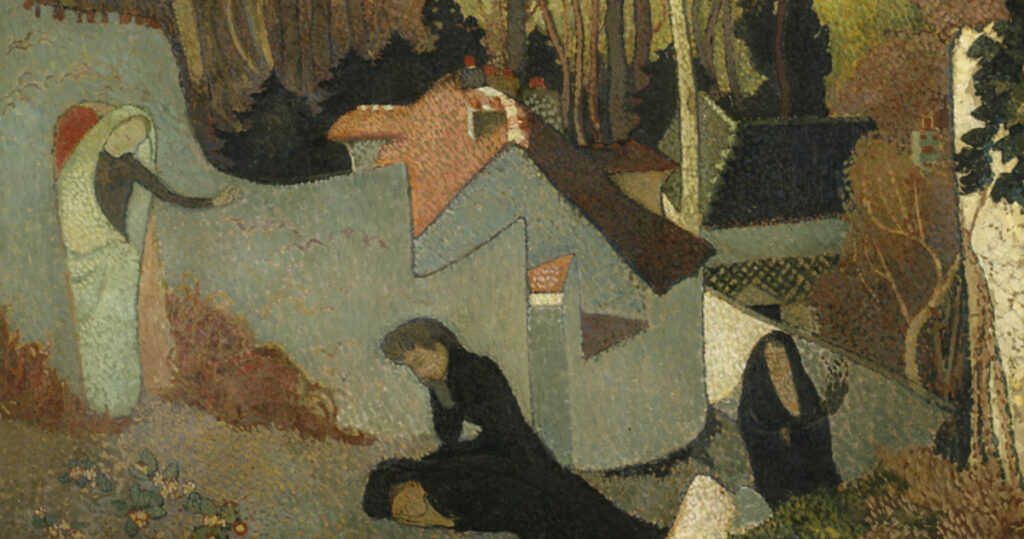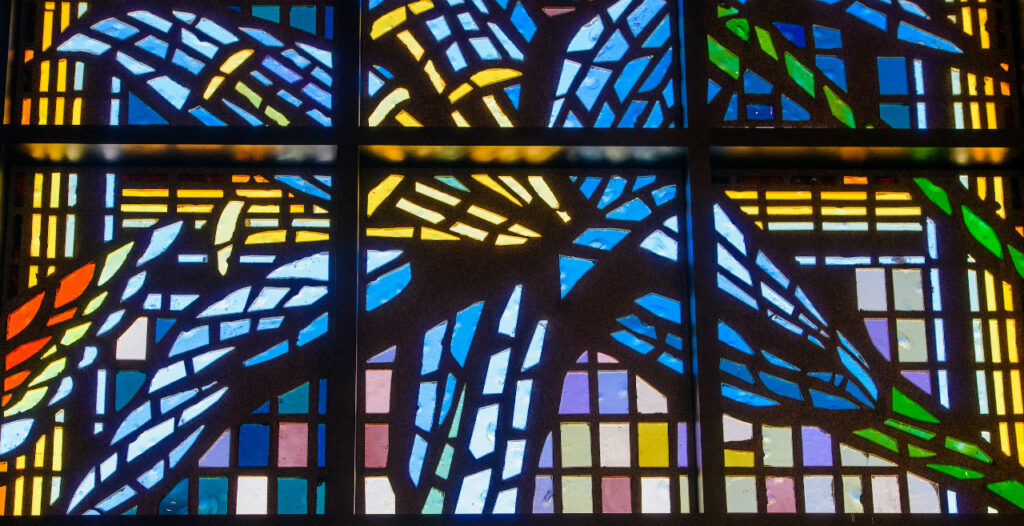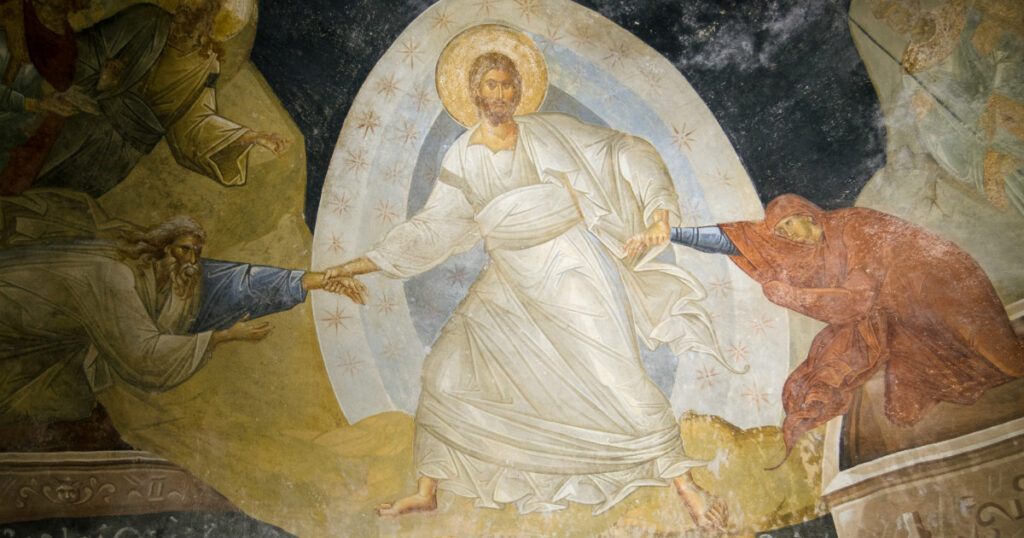An art reflection by Leonard Payton on Maurice Denis's "Easter Mystery." This is one installment of a monthly series providing reflections on works of art and music from a Lutheran perspective.
Conspicuously, in some early manuscripts of Mark[1], no one sees the risen Christ. It invites the question: Why? Surely Mark knew that Jesus had been seen. Mark had been a travelling companion of Saint Paul, who, in 1 Corinthians 15, wrote that Christ was seen after the resurrection by lots of people (including 500 at one time!), many of whom were still alive at the time of Paul’s writing. Why might Mark have avoid mentioning any sighting of the risen Christ?
I think Maurice Denis and his work “Easter Mystery” might help us answer that question. His painting is really two stories on one canvas, divided by a line of deciduous trees running horizontally across the picture. We will sort out the story in the foreground, and then move to that less obvious story behind the trees, and then finally pull them together.

A second and greater Passover
In the lower right hand corner are three mourning women. The woman farthest right is carrying spices. Indeed, that sturdy branch in her hand could be hyssop, the same plant used on the night of the Passover, when the Israelites painted the doorposts and lintels of their houses with the blood of a lamb using a hyssop branch. The entrance of the tomb is Passover-blood red, signifying a second and greater Passover. We are reminded of the words from Luther’s great Easter hymn, “See, His blood now marks our door; Faith points to it; death passes o’er” (LSB 458). Our marked door is the door to Christ’s tomb.
Just inside that door to the tomb is a “young man … dressed in a white robe” (Mark 16:5). He clearly does not have a man’s beard, so he is young. Maurice Denis is being careful to construe the text accurately in his painting. God be praised for painters who have that kind of honor for the text!
We know from the other Gospel accounts that there were two angels at the tomb. But Mark mentions only one, and describes him as a “young man … dressed in white.” We know from other biblical accounts that angels sometimes appear in the form of men. Just a couple of chapters earlier, a young man wearing only a linen cloth fled into the night during Jesus’ arrest. When the enemies of Jesus grabbed for that young man, he had to leave that linen cloth behind. What did his mother think when he came home bare? Imagine the shame … not just the nakedness, but the cowardice as well. Only Mark mentions this young man. Some people suspect that this young man in a linen cloth was Mark himself, and considering Mark’s evidently cowardly departure years later when Paul and Barnabas arrived in Pamphylia from Cyprus, I suppose that might be in character.
Is it possible that in describing the angel as a “young man dressed in a white robe,” Mark wants us to think back to the young man in linen who fled — and by calling to mind that cowardly flight here at the moment of resurrection, that the angel serves as a symbol of the forgiveness and restoration Mark received through the resurrection of Jesus? Mark was a spare writer. The young man in white matters because the Holy Spirit saw fit to include it in Mark’s account.
The Passover comes to us
Now consider the second story in this painting, the one going on behind that line of deciduous trees in the middle ground.
There are several figures in white all moving toward the house deep in the background. While it is daylight, the sun has not yet risen. The light and the shadows are muted. The door of that house is the same red that we saw in the door to the tomb. Indeed, except for four small seemingly insignificant chimney pots in the foreground, those two red doors are the most striking color in an otherwise subtle painting.
Of course, Maurice Denis wants you to connect the two doors. We know what the first door is. But what is the second? It’s the place where God’s people, the church, will gather. It is the place of the presence of Word and Sacrament. It is the place where that second and greater Passover comes to us. All those people in white moving toward that door are freshly baptized people going to receive the Eucharist on Easter morning. They have been clothed with Christ in Baptism. Their shame has been taken away. They have been adopted into Christ and are welcome at the family meal.
Both tableaux, the empty tomb in the foreground and the church deep in the background, are realistic, even if a little stylized. The painting does not shout absurdity at us the way, say, a painting of Salvador Dali or Rene Megritte would — clocks sliding off the table like a fried egg, or a pressed-and-starched business man with a green apple nose.
Where is the risen Christ?
And yet, there is one element that almost seems absurd. I say “almost,” because I don’t think Maurice Denis inserted it for its absurd value. I think he was catechizing by this one element, an element that is the center of the whole work and his reason for painting it in the first place.
It’s in that line of deciduous trees running across the middle of the picture. There are three dark trunks clumped closely together a little to the left. The trunk on the right should draw our attention. There is a hand coming out of it, and in that hand is a communion wafer. That’s the pastor’s hand. You don’t need to see any other part of him. With his hand, he is answering the question that Mark forced us to ask: “Where is the risen Christ?” He’s in the bread of the Eucharist. The worshipers many centuries later get to see the risen Christ in the Divine Service.
It is conspicuous that the hand is coming out of a tree which is part of a cluster of three. We know that Jesus was crucified along with two other men, and that they were on either side of him. Why isn’t the hand coming out of the center tree in Maurice Denis’ painting? I think it’s only a matter of practicality. Placing the hand in that center tree would have forced more distance between the three trees, and then the eye might not have grouped them so easily. Artists sometimes have to shift and move things in order to say what they need to say. Further, while to our eyes that row of trees appears to be on the same plane, from the vantage point of the figures in white robes, the tree with the hand may be closer to them, thus placing it in the middle.
Our proper preface for Holy Week says, “It is truly good, right, and salutary that we should at all times and in all places give thanks to You, holy Lord, almighty Father, everlasting God, through Jesus Christ, our Lord who accomplished the salvation of mankind by the tree of the cross that, where death arose, there life also might rise again and that the serpent who overcame by the tree of the garden might likewise by the tree of the cross be overcome.” I think Maurice Denis captured this thought.
But did he really? Did Denis deliberately plan all the elements I have described? I cannot say for certain. Artistic intuition can be highly elaborate and insightful, even if the artist does not proceed from an orderly outline. Music theorists continue to study and find new depths in the works of Bach and Mozart, and yet, those two composers often worked so fast — Bach especially! — that the notion of planned schematics executed in an orderly fashion is as absurd as the green apple nose on Magritte’s businessman.
I don’t know Maurice Denis’ biography well. It is clear from some of his other works that his faith and church life mattered to him. They were the stuff that swirled around in his mind as he painted. If the heavens declare the glory of God, then what’s to stop a painter from telling a rich Jesus story too, even if he wasn’t fully aware of it?
[1] Later manuscripts include Mark 16:9–20, Mark’s “longer ending,” which does include such sightings as well as the Great Commission. However, some earliest manuscripts omit these verses.




